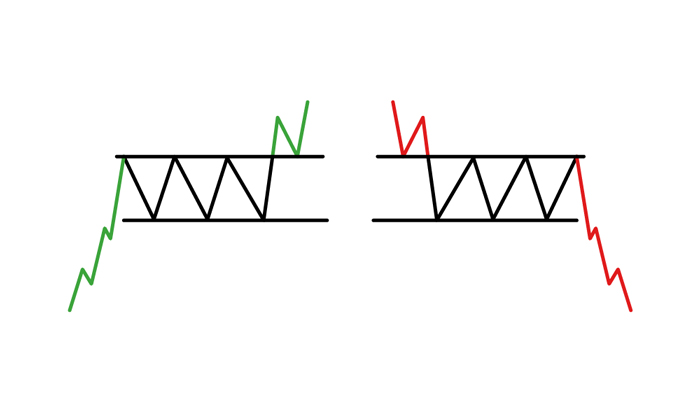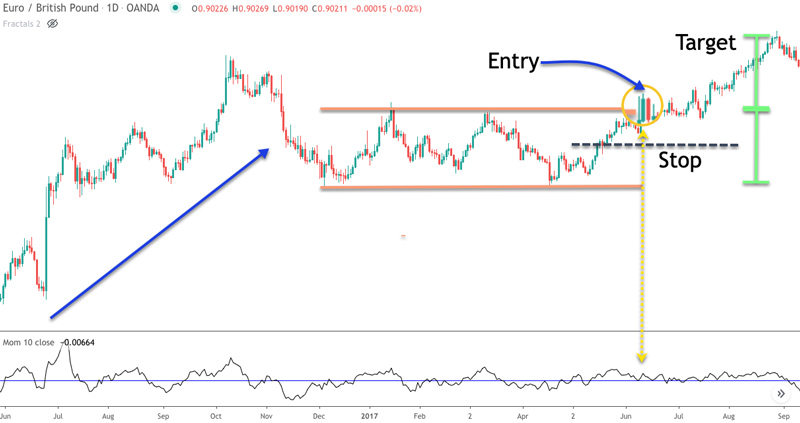What you are about to read:
Forex transactions are a popular method for investment and earning income in financial markets. However, successful trading requires understanding various chart patterns and effective analysis. One of the most popular and widely used patterns is the rectangle chart pattern.
In previous articles, BrokerLand introduced patterns such as the triangle chart pattern and flag patterns in forex trading. Here, we present another pattern: the rectangle pattern. This pattern is a continuation pattern that forms when the price of an asset trades within a rectangular range for an extended period. This pattern is characterized by two parallel horizontal lines, with the upper line acting as resistance and the lower line as support.
The strategy for the rectangle chart pattern believes that when the price breaks out of the pattern, it usually indicates a continuation of the existing trend. In other words, if the price was in an uptrend before the pattern, a breakout to the upside suggests a continuation of the uptrend. Conversely, if the price was in a downtrend before the pattern, a breakout to the downside indicates a continuation of the downtrend.
In this article, we will also examine how to identify and trade the rectangle pattern in forex, as part of the Brokerland forex learning.
Identifying the Rectangle Chart Pattern
Identifying the rectangle pattern is relatively simple. Traders can draw two horizontal trend lines connecting the price high and low. These trend lines should be parallel, indicating that the price is trading within a rectangular range.
It is essential to note that the reliability and validity of the pattern depend on the trading style and strategy. The pattern can occur on various time frames, from minutes to weeks. It is more reliable and valid when it occurs on longer time frames, such as daily or weekly charts.
Once the rectangle chart pattern is identified, traders can predict a breakout from it, which can lead to a significant price movement. As mentioned earlier, a breakout to the upside indicates a continuation of the uptrend, while a breakout to the downside indicates a continuation of the downtrend.
How To Trade Rectangle Pattern
Trading with the rectangle pattern requires a combination of technical analysis tools and trading strategies. Here are the steps to follow when trading with this pattern:
1. Identify theBrokerland Pattern
The first step is to identify the pattern on the forex chart. As mentioned earlier, this pattern is characterized by two parallel horizontal lines connecting the price high and low.
2. Determine the Breakout Direction
The second step is to determine the breakout direction. Traders can predict the breakout by analyzing the previous trend before the pattern formation. If the price was in an uptrend before the rectangle pattern, there is a higher probability of a breakout to the upside. Conversely, if the price was in a downtrend, there is a higher probability of a breakout to the downside. Be cautious of false breakouts during this stage.
3. Wait for the Breakout
The third step is to wait for the breakout to occur. Traders should closely monitor the price to identify signs of a breakout. It’s essential to note that false breakouts may occur, so traders should wait for confirmation before entering a trade.
4. Enter the Trade
The fourth step is to enter the trade after the breakout is confirmed. Traders can go long if the price moves upward or short if the price moves downward. Depending on the exit direction, the entry point should be slightly above or below the breakout point.
5. Set Stop-Loss and Take-Profit Levels
The fifth step involves setting forex orders (stop-loss and take-profit levels). The stop-loss level should be placed below the support line for long trades and above the resistance line for short trades. Take-profit levels can be determined using technical analysis tools such as Fibonacci retracement or by considering the risk/reward ratio.
6. Manage the Trade
The final step is to manage the trade by monitoring price action and adjusting stop-loss levels if necessary. Traders should also consider taking partial profits if the trade moves in their favor. It’s crucial to note that while the rectangle chart pattern can lead to significant price movements, it is not a guaranteed success. Traders should always practice proper risk management and have a trading plan in place.
Several Rectangle Pattern Strategies
Here are several trading strategies that traders can use with the rectangle pattern:
- Breakout Strategy
The breakout strategy involves waiting for the price to exit the pattern and entering a trade in the breakout direction. Traders can use technical analysis tools such as moving averages, trend lines, and oscillators to confirm the breakout.
- Range Trading Strategy
This strategy with the rectangle pattern involves buying at support levels and selling at resistance levels. Traders can enter a long trade when the price reaches the support level and exit when the price reaches the resistance level. Conversely, traders can enter a short position when the price reaches the resistance level and exit when the price reaches the support level.
- Price Action Rectangle Pattern Strategy
The price action strategy for trading with this pattern includes using price action and price movements alone to identify this pattern and trade the breakout. Traders can use candlestick patterns and chart patterns to identify the pattern and confirm the breakout.
Conclusion
In this article from Brokerland, the rectangle pattern was introduced which is a popular and common chart pattern in forex trading. This pattern is characterized by two parallel horizontal lines, with the upper line acting as resistance and the lower line as support. When the price breaks out of the rectangle pattern, it usually indicates a continuation of the existing trend.
Traders can use technical analysis tools and trading strategies to identify and trade this pattern. However, traders should always have proper risk management and a trading plan to ensure long-term success in forex trading.











